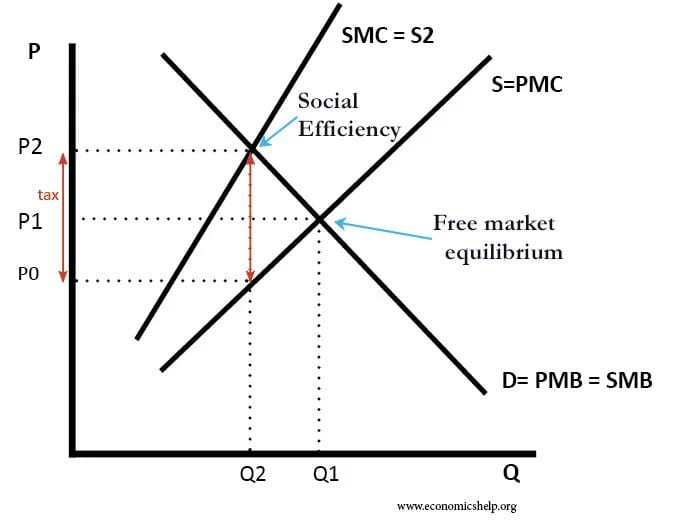Climate change, and society’s response to it, presents risks that could impact our monetary and financial stability objectives. Financial and economic risks can arise from events such as floods and droughts, e.g. insurance firms facing higher claims. Risks can also arise in the transition to a low-carbon economy, like changes in government policy and technology. what can be done to mitigate those risks?
With the acceleration of the pace of industrialization in the world, the uncontrolled growth of greenhouse gases(Carbon dioxide and methane) emissions has caused more and more damage to the earth’s ozone layer, which has led to more and more problems in the world’s climate, and important for us to find out a solution to stop this issue of climate change.
One of the keyways to solve this environmental problem is to internalize the negative external cost to ensure that those who create externalities include us when making decisions. ‘Making the polluter pay’ is one of the common approaches to adjust for externalities. The UK government imposes a landfill tax on the local rubbish authorities to increase the private cost of production. This ought to reduce demand and output for the goods and services that are creating negative externalities so that the market equilibrium will shift to Q2P2 where the social efficiency is. The UK currently has a shortage of land for burying the waste and the landfill site. The external cost of the landfill is the huge amount of methane released into the air which is 20 times more polluting than CO2 at each one of the landfill-site. The tax had a base rate of £7-per-tonne in 2002 rising to £80 in 2014. There are arguments that the revenues from pollution taxes should be used to reduce the extra externalities made by landfill, to protect or enhance our environment. For instance, these tax revenues can be transferred to subsidies and directly giving to the researches for new technology for reducing pollution, such as project turning methane into hydrogen. Methane with hydrogen can become a cleaner energy-natural gas that can be used for cooking and heating, meanwhile reducing methane emission. Therefore, by giving subsidy to research in new technology and this shifts the market equilibrium to Q0 and gets to the point where the market equilibrium is socially efficient and therefore reduces pollution.


To further reduce the pollution, it is important that individuals; we and businesses create less waste and a smaller carbon footprint in the first place. Meanwhile, Governments should make more effort to tell people to, re-use products and recycle more. More information and Posters, such as contents about ‘pollutions/hazards to us/climate change’ should be made to warn people to pollute less. For example, in China, the ‘’Center for Environment Education and Communications of Ministry of Ecology and Environment’ teaches people about national environmental laws, regulations, and policies and organize a variety of environmental protection theme activities for student and the society. Governments should also be planning a ‘’green GDP’’ mode of which main job is to reduce carbon emission and guide people to have a ‘’low-carbon life’’.
So as one of the humans in all 7.7Billions population, I strongly encourage Governments to take action and start the change. Governments, households, and firms need to work towards the same target of reducing pollution and fix the externalities we have made before it’s too late.
随着世界工业化步伐的加快,温室气体(二氧化碳和甲烷)的排放不受控制地增长对地球上的臭氧层造成越来越多的破坏,从而导致世界上越来越多发生的气候问题,对于我们而言,找到解决这一气候变化问题的解决方案迫在眉睫。
解决此环境问题的关键方法之一是将外部成本内部化,同时包括我们在制定决策时减少外部成本。 “让污染者付费”是调整外部性的常见方法之一,现在英国政府对本地的垃圾掩盖厂征收垃圾掩埋税,以增加私人生产成本,因此对商品和服务产生外部性的需求和产出减少,以使市场均衡将转移至社会效率所在的Q2P2,英国目前缺乏用于掩埋废物和垃圾掩埋场的土地,垃圾填埋场的外部成本是释放到空气中的大量甲烷,这是每个垃圾填埋场的二氧化碳污染的20倍,该税的基准税率从2002年的每吨7英镑提高到2014年的80英镑。有人提出,污染税的收入应用于减少垃圾填埋场产生的额外外部性,以保护或改善我们的环境。例如,这些税收可以转移到补贴中,直接用于减少污染的新技术的研究,例如将甲烷转化为氢气的项目。含甲烷的甲烷可以成为一种更清洁的能源天然气,可用于烹饪和加热,同时减少了甲烷的排放。因此,通过对新技术的研究给予补贴,这会将市场均衡转移到Q0,并达到市场均衡对社会有效的程度,从而减少了污染。
为了进一步减少污染,首先,我们和企业需要创造更少废物,更小的碳足迹。同时,政府应加大力度告诉人们使用,废物利用和回收利用更多资源,同时制作更多的信息和海报,例如有关“污染/对我们的危害/气候变化”的内容,以警告人们减少污染。例如,在中国,“生态与环境部环境教育与传播中心”向人们传授有关国家环境法律,法规和政策的信息,并为学生和社会组织了各种环境保护主题活动。各国政府还应该规划一种“绿色GDP”模式,其主要工作是减少碳排放并指导人们拥有“低碳生活”。
因此,作为77万万人口中的人类之一,我强烈要求各国政府采取行动并开始改变。政府,家庭和企业都必须朝着减少污染的目标努力,并在我们为时已晚之前解决问题。
Andy Kot, Year 13.
